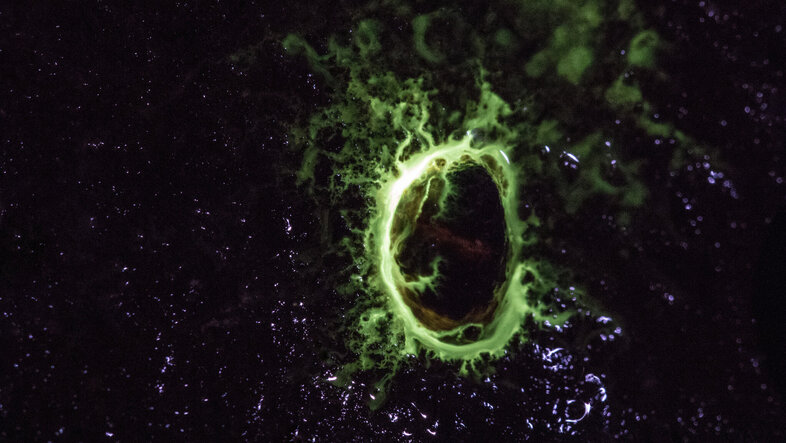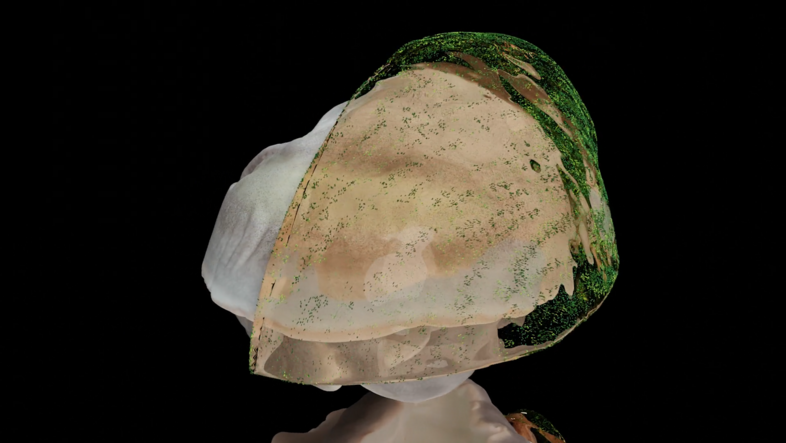Glowing snail mucus: The sticky future of biomaterials
Imagine you are a small snail living in a river in New Zealand and need to defend yourself against hungry dragonfly larvae and eels. Your shell offers not enough protection, so what can you do? "The freshwater snail Latia neritoides has a unique defence strategy: It blinds its attackers with glowing green mucus. This mucus confuses the aggressors and sticks to them, making them visible to other predators," explains the zoologist Sophie Greistorfer. Her current research focuses on this luminous slime with promising properties as a biomaterial.
The doctoral candidate at the Vienna Doctoral School of Ecology and Evolution (VDSEE) follows two tracks: By analysing and describing the gland cells of Latia neritoides, she tries to find the source of the glowing mucus. Secondly, she examines the proteins of the defence mucus and their biochemical properties. "As a reference in this analysis, I use another species of freshwater snails that does not secrete glowing mucus," says the winner of the Impact.Award 2023, a prize for outstanding dissertation projects with the potential to achieve social, cultural or economic added value.
From a river in New Zealand to the lab at the University of Vienna
The young researcher had the opportunity to collect the snails herself during a field trip to New Zealand. "Here in Vienna, I analyse them: the morphology of their glands, the biochemistry of their mucus," says Greistorfer, explaining how she approaches her study, "A typical working day in the histology lab starts with cutting a snail into thin pieces to stain it the next day. In the next step, I examine the slices and digitise them using microscopes." Many lab days and a lot of snails later, she says, "After separating the proteins in the mucus using gel electrophoresis, I now know that snail mucus is undeniably one of the most promising biomaterials."
16 Vienna Doctoral Schools. Since 2020.
Since 2020, the Vienna Doctoral Schools provide excellent conditions including team supervision and various funding possibilities that enable the realisation of international competitive research. In the doctoral schools, doctoral candidates find an active and inspiring research environment, a vibrant doctoral community and many ways to connect with peers from home and abroad on a social and professional level.
A promising material from nature without heavy metals
The snail mucus has a wide range of potential applications. "For example, in the treatment of burns, skin regeneration or the healing of abscesses," emphasises Greistorfer. A wide array of luminescent biopolymers – for example, derived from cellulose, chitosan, or gelatin – are already used in optical and mechanical applications as well as in drug delivery and biosensor applications. However, for this purpose often toxic luminescent components containing heavy metals, such as cadmium, lead and selenium are used. "They have cytotoxic side effects which make these biopolymers less appealing for human-oriented applications," says Greistorfer.
It is the hope of the researcher that a better understanding of the luminescent mucus system of Latia neritoides will also provide an insight into the basic principles of this luminescent biopolymer. "Furthermore, the underwater bonding capability of luminescent mucus offers additional opportunities for applications in aqueous and liquid sensors."
Underwater bonding: Applications in medicine
In the long term, insights into the composition and bonding mechanisms of the snail mucus could provide the basis for innovative aqueous adhesives – particularly suited for medical applications in moist environments, such as hemostasis, tissue sealing and nerve connectivity. "It is also crucial to assess the effectiveness of these new biomaterials to secure funding and further research in this field, ultimately enhancing the healthcare outcomes for patients," says the young scientist.
Originally, Greistorfer wanted to study marine biology at the University of Vienna, but sometimes things turn out differently and she ended up in zoology: "Biologist Janek von Byern, who had previously done research in New Zealand, drew my attention to the snails and adhesives. During my master’s in his research group at the University of Vienna, I became aware of how important and fascinating research on new biomaterials is." (red)

